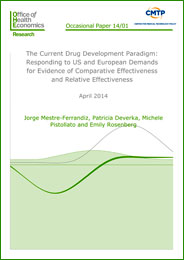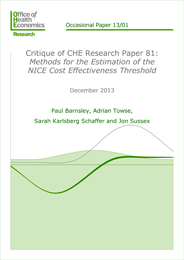Medicines Adaptive Pathways: A Practical Strategy to Improve Patient Access to Medicines?
In September 2014 the Centre for Innovation in Regulatory Science held a workshop with invited regulators, health technology assessment (HTA) bodies and payers, industry and academics on “Medicines Adaptive Pathways: A Practical Strategy to Improve Patient Access to Medicines?”. The aims of the workshop were to discuss new regulatory approaches to accelerating medicines availability, and suggest recommendations on how best to ensure success of new Facilitated Regulatory Pathways.
OHE’s Adrian Towse presented an academic perspective, arguing that a commercial model for an adaptive pathway required a form of coverage with evidence development (often called Managed Entry Agreements or Performance Based Risk Sharing Arrangements), along with a transformation in evidence collection costs through electronic health records (EHRs), disease registries, and methods evolution. Regulatory / HTA / company interaction on post-launch evidence requirements would be required. The company perspective was presented by Dr Jens Grueger; Hoffmann-La Roche, Switzerland.
For additional information please contact Adrian Towse at OHE.
Models for Health Economic Evaluation – a European perspective
OHE’s Jorge Mestre-Ferrandiz delivered a presentation in Lisbon on 1st October during the conference “Access to Innovation – A conditioned reality”. This conference was part of Apifarma’s Cycle of Conferences “Saber Investir, Saber Inovar”. The presentation began with a discussion of the current challenges/issues around the innovation landscape, and moved on to look closely at models of health economic evaluation in France, Germany and the UK. This presentation can be watched here
http://www.youtube.com/watch?v=AyoScR9BjuU, from 00:29:27 to 1:28:00.
For additional information please contact Jorge Mestre-Ferrandiz at OHE.
Using stated preferences to guide health care resource allocation decisions
Speaking in London on 10th October 2014 OHE’s Koonal Shah gave a presentation as part of the Department of Health’s Speakeasy seminar series. Koonal provided a general introduction to how cost-effectiveness and analyses based on the quality-adjusted life year (QALY) are used to guide HTA decisions in the UK. He then reviewed the debate on whether all QALYs are of equal social value, focusing on the research question of whether society places special value on QALYs accruing to patients near the ends of their lives. A mixed picture emerges from the empirical literature, with some studies reporting evidence of public support for an end of life premium and other studies reporting the opposite.
For additional information please contact Koonal Shah at OHE.
Incorporating life-cycle price modelling into pharmaceutical cost-effectiveness analysis
OHE’s Michele Pistollato delivered a presentation on pharmaceutical life-cycle price modelling at the third annual Pharmaccess Leaders Forum held in Berlin from 8-10 October 2014. Michele’s presentation explained life-cycle pricing and why it is important that it is considered when performing cost-effectiveness analysis. Michele noted that neglecting life-cycle pricing in such analyses could lead to some cost-effective technologies not being recommended for reimbursement. This is therefore a key topic for HTA bodies and manufacturers.
Michele presented on the same theme at the 19th Annual Conference of the Italian Health Economics Association (AIES), which was held in Venice on 27th and 28th October. The topic of the conference was the financing of healthcare and welfare models in the era of longevity.


